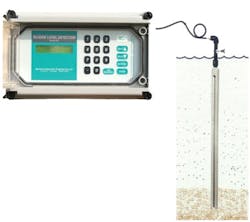Sludge Level Detector Helps Users Find Blanket
Markland’s detector allows water and wastewater treatment plant operators to program de-sludge pumps to operate only when necessary, preventing carryover and helping to optimize feed density and reduce energy usage. By measuring, monitoring and controlling solid-liquid interface levels in clarifiers and settlement tanks at municipal and industrial plants, it helps reduce wear and tear on pumps, downtime for maintenance and energy costs.
This instrument uses high-intensity infrared light to measure primary, secondary and backwash silt and sludge blanket levels when treating raw and wastewater, including applications in lamellas, decanting tanks, dissolved air flotation thickeners, sequencing batch reactors, hoppers, upflow filter reactors and sedimentation basins. Automating sludge removal pumps helps users avoid pumping thin sludge or large volumes of water, such as when a core hole is pulled. This, in turn, helps enhance filter press, centrifuge and digester performance, and improves outflow for reuse. In addition, in dissolved air flotation units, the detector can adjust surface skimmer speeds to match variations in the thickness of the floating sludge layer; in sequencing batch reactors, it can control the decant valve to minimize cycle times.
The detector uses a vertical probe (4- and 8-ft models are available), submerged only to a depth required to encompass the desired sludge level range (often offset from the bottom of the tank). LED-phototransistor sensors running the length of the probe are sequentially scanned to locate both the settled bed and the overlying cloud layers, automatically adjusting intensity for different concentrations. When sludge levels reach the preferred maximum or minimum, the controller signals a computer control system to turn the sludge removal pumps on or off.
A slim profile and use of LEDs make this automatic sludge blanket level detector suitable for obstructed or constricted areas. For example, the inclined plates of lamellas do not affect readings. No calibration is required.
